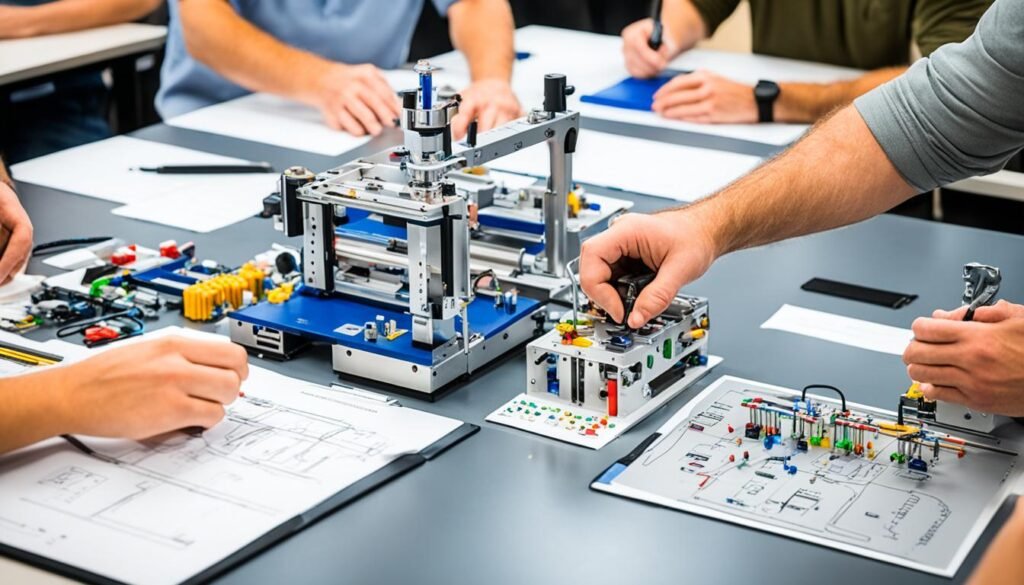Degree courses play a crucial role in elevating education and propelling careers. In a rapidly changing and competitive post-pandemic world, institutions of higher education must innovate to meet the needs of students and industries. There is increasing scrutiny on the relevance and value of degree programs, affordability, and the role of technology. The traditional models of education need to be updated to incorporate current content, engagement, and technology.
Access to education should be inclusive, with flexible schedules and a range of modalities. The opportunity to gain knowledge and skills should be available to all, regardless of socioeconomic status. The promise of higher education should be within everyone’s reach, and financial structures should be reimagined to control costs and increase affordability. Employability is also critical, with the need for knowledge to intersect with relevant job skills. Integration of technology and the promotion of diversity and equity in academic programs are key factors for success in a rapidly changing workplace.
Also Read: The Unique Identity Of Misericordia University
Key Takeaways:
- Degree courses are essential for career advancement and expertise.
- Higher education institutions must innovate to meet the changing needs of students and industries.
- Access to education should be inclusive and affordable.
- The integration of technology and diversity is crucial in academic programs.
- Higher education plays a transformative role in the rapidly changing workplace.
The Need for Innovation in Higher Education
In the rapidly changing landscape of education, institutions that prioritize innovation are best positioned to meet the evolving needs of students and industries. Higher education faces a growing challenge of demonstrating its relevance and value amid discussions about its role in shaping the future.
Traditional models of education, developed centuries ago, no longer align with the needs of today’s learners. Outdated content, lack of engagement, and limited integration of technology have resulted in a perception that higher education is losing its relevance. To address this, significant decisions must be made to transform education, making it more inclusive, accessible, and impactful.
Also Read: How Does Harvard University Foster Innovation And Research?
Ensuring access to education should no longer be constrained by time, location, or finances. Innovative approaches such as online and hybrid modes of delivery can provide convenience and flexibility for learners, catering to their diverse needs. By embracing these modalities, higher education can bridge the gap between expectations and reality, preparing students for success in the digital age.
“Education is the passport to the future, for tomorrow belongs to those who prepare for it today.” – Malcolm X
Meeting the Needs of Students and Industries
Higher education must prioritize meeting the needs of both students and industries. With the rapid advancements in technology and changing job market demands, educational programs must evolve to equip students with the skills and knowledge required to thrive in their chosen fields.
“Innovation distinguishes between a leader and a follower.” – Steve Jobs
An innovative approach to higher education involves integrating industry needs into the curriculum, ensuring that graduates are job-ready upon completion of their degree programs. This means engaging with industry professionals, identifying emerging skill requirements, and adapting programs accordingly. Collaboration between academia and industry can foster a dynamic learning environment that aligns with market demands.
Also Read: Education Lawyer Services For Academic Issues
The Relevance and Importance of Innovation
Embracing innovation in higher education is crucial for numerous reasons. First and foremost, it ensures that students receive life-changing educational experiences that prepare them for successful careers. By leveraging technology, interactive teaching methods, and interdisciplinary collaborations, institutions can provide a holistic and relevant education that equips graduates with the skills needed to excel in the modern workforce.
“Education is not preparation for life; education is life itself.” – John Dewey
Moreover, innovation in higher education contributes to the overall advancement of society. By encouraging research, fostering creative thinking, and promoting problem-solving skills, institutions become engines of knowledge and innovation. This, in turn, benefits industries, communities, and the economy at large.
Embracing the Future
As the world continues to change, higher education must adapt and embrace the future through innovation. By doing so, institutions can ensure their ongoing relevance, attract and retain students, and support the needs of industries. The journey towards innovation in higher education is an ongoing one, requiring collaboration, experimentation, and a commitment to continuous improvement.
Also Read: Beyond Basics: Advancing With Diploma Courses
| Benefits of Innovation in Higher Education | Impact on Students | Impact on Industries |
|---|---|---|
| Enhanced learning experiences | Preparation for the modern workforce | Access to job-ready graduates |
| Promotion of critical thinking | Increased employability | Alignment with industry needs |
| Development of future leaders | Acquisition of relevant skills | Accelerated innovation and growth |
Equitable Access to Education

Equitable access to education is essential to ensure that knowledge and skills are available to all, regardless of socioeconomic status or position in life. Working adults, returning learners, and underserved students should have equal opportunities to pursue higher education. Traditional models of education often focus on the progression of students directly from high school to a degree, neglecting the needs of those with family and career responsibilities.
Access to education should be on the learners’ terms, with scheduling flexibility and a range of modalities. Physical and digital expansion through campuses and online platforms can provide 24/7 access to knowledge. Efforts should be made to change the narrative and actions at the K-6 levels and in the community, to affirm each learner’s ability to succeed irrespective of background or position in life. Mechanisms such as college-preparation programs and early engagement initiatives can enhance access and success for underserved students.
Benefits of Equitable Access to Education
- Empowers working adults to pursue educational opportunities while juggling familial and professional responsibilities
- Gives returning learners a second chance to acquire the education they need for career advancement
- Opens up educational pathways for underserved students who may face barriers due to socioeconomic circumstances
- Promotes equal opportunities for traditional students, ensuring fairness in the education system
“Equitable access to education empowers individuals from all walks of life to pursue their dreams, expand their knowledge, and improve their lives. By removing barriers and offering flexible learning options, we can ensure that every individual has an opportunity to thrive and contribute to society.” – Jane Johnson, Education Advocate
Providing Equitable Access: Strategies and Initiatives
| Strategies and Initiatives | Description |
|---|---|
| Flexible Scheduling | Offering classes and programs at different times to accommodate the needs of working adults and those with family responsibilities |
| Online Learning | Providing digital platforms and resources to support remote learning, allowing students to access education from anywhere |
| Financial Aid and Scholarships | Ensuring that financial constraints do not hinder access to education through the provision of grants, scholarships, and student loans |
| Mentorship Programs | Pairing underserved students with mentors who can provide guidance and support throughout their educational journey |
| Early Intervention Programs | Introducing college-preparation initiatives at the K-6 levels to instill confidence and academic readiness in underserved students |
By implementing these strategies and initiatives, educational institutions can ensure that equitable access to education becomes a reality, empowering individuals to pursue their educational goals, advance their careers, and uplift their communities.
Also Read: Student Life At South University Austin: What To Expect?
The Role of Technology in Higher Education

Technology plays a crucial role in transforming higher education. Institutions must embrace appropriate technologies, such as online delivery, AI/ML, and analytics, to reach learners and provide resources and support when, where, and how they need them.
Online Delivery
Online delivery platforms have revolutionized education, offering flexibility, convenience, and accessibility to learners worldwide. Through online courses, students can access quality education from the comfort of their homes, eliminating geographic barriers and allowing for personalized learning experiences.
AI/ML and Analytics
The integration of artificial intelligence (AI) and machine learning (ML) technologies is reshaping higher education. AI-powered tools can analyze vast amounts of data to identify learners’ needs, provide personalized interventions, and improve learning outcomes. Analytics help institutions track student progress, identify areas for improvement, and make data-driven decisions to enhance teaching effectiveness.
Technology plays a crucial role in transforming higher education. Online delivery, AI/ML, and analytics empower institutions to provide personalized learning experiences and improve teaching effectiveness.– Harvard Higher Education Research Institute
Immersive Experiences through XR/AR/VR
Extended reality (XR), augmented reality (AR), and virtual reality (VR) technologies enable immersive learning experiences that go beyond traditional classroom settings. These technologies engage learners through interactive simulations, virtual field trips, and hands-on practice, enhancing comprehension and retention.
Addressing Digital Deserts
While technology offers immense opportunities, it is crucial to address the issue of digital deserts and ensure equal access to technology resources. In underserved areas with limited internet connectivity and technological infrastructure, comprehensive solutions are needed, including initiatives to improve Wi-Fi access and bandwidth availability.
By harnessing the transformative power of technology, higher education institutions can create inclusive learning environments, equip learners with essential digital skills, and prepare them for the evolving demands of the modern workforce.
| Technology | Application |
|---|---|
| Learning Management Systems (LMS) | Centralized platforms for course management, content delivery, and assessment |
| Virtual Laboratories | Simulated environments for hands-on experimentation and practical learning |
| Adaptive Learning Software | Personalized learning experiences tailored to individual student needs |
| Collaboration Tools | Online platforms for real-time collaboration, discussion, and project work |
| Data Analytics | Analysis of student performance data to inform instructional strategies and interventions |
| Virtual Reality (VR) | Immersive simulations and virtual field trips for enhanced experiential learning |
With the integration of technology in higher education, learners gain access to innovative learning tools, tailored instruction, and immersive experiences that enhance their educational journey and prepare them for success in the digital age.
Affordability and Financial Structures in Higher Education

The promise of higher education should not be restricted to those with means or those willing to take on crippling debt. Dramatic changes in financial structures are needed to ensure affordability and control costs. Institutional, state, and federal policies regarding financial aid and scholarships should be reevaluated to support a fast-changing demographic of students.
Lowering the costs of higher education is crucial to increase access and promote return on investment. Students deserve clarity on the actual cost of obtaining a degree and the value it provides in terms of career advancement and socioeconomic mobility. Metrics such as the factored-graduate-return can provide insights into the return on investment.
Transparency in how resources are used and accountability in achieving academic success and socio-economic mobility are vital factors in ensuring affordability. To illustrate the impact of financial structures in higher education, consider the following table:
| Costs | Financial Aid | Scholarships | Lower Costs | Return on Investment |
|---|---|---|---|---|
| $20,000 | $10,000 | $5,000 | $15,000 | 25% |
| $30,000 | $15,000 | $7,000 | $23,000 | 20% |
| $40,000 | $20,000 | $10,000 | $30,000 | 15% |
As shown in the table, a combination of financial aid, scholarships, and lower costs can significantly impact the return on investment for students. It is essential for institutions and policymakers to prioritize affordability and make higher education accessible to all.
The Importance of Financial Aid and Scholarships
Financial aid and scholarships play a critical role in making higher education affordable for students from diverse backgrounds. By reducing the financial burden, they open doors of opportunity and empower individuals to pursue their academic and career goals.
Financial aid programs, such as grants, loans, and work-study opportunities, provide students with the necessary financial support to cover tuition, books, living expenses, and other educational costs. These programs can help bridge the affordability gap and ensure that students can focus on their studies without excessive financial stress.
Scholarships, on the other hand, are merit-based or need-based awards that can further reduce the financial burden of higher education. They are often awarded based on academic achievement, extracurricular involvement, community service, or special talents. Scholarships can provide significant financial assistance to deserving students and make higher education more accessible.
Lowering Costs for Students
Lowering the costs of higher education is essential to enhance affordability and ensure that students can pursue their educational goals without incurring excessive debt.
Higher education institutions should prioritize cost reduction efforts by exploring various strategies. This can include implementing cost-effective technology solutions, leveraging open educational resources, promoting textbook affordability initiatives, and streamlining administrative processes to eliminate unnecessary expenses.
By embracing innovative approaches and efficient resource allocation, institutions can help lower the overall costs of higher education, making it more accessible to a wider range of students.
Maximizing Return on Investment
Return on investment in higher education refers to the value and benefits students receive from their educational experience in relation to the costs incurred.
When considering the return on investment, it’s important to look beyond the upfront costs of tuition and consider the long-term benefits in terms of career advancement and earning potential. Higher education equips individuals with the knowledge, skills, and networks necessary to succeed in their chosen fields.
Students should assess the potential return on investment by considering factors such as average starting salaries, employability rates, and opportunities for advancement in their desired career paths. By making informed decisions and identifying programs that provide strong career outcomes, students can maximize their return on investment and ensure long-term financial stability and success.
Ultimately, ensuring affordability and financial structures in higher education is crucial for creating a fair and accessible system that empowers students from diverse backgrounds to pursue their educational and career aspirations.
Integration of Skills Development in Academic Curricula

In the 21st century, higher education must go beyond imparting academic knowledge and effectively integrate skills development into academic curricula. It is essential for students to cultivate job-ready skills that prepare them for the demands of the workforce.
One key aspect of skills development is the integration of technology awareness and competency with a traditional liberal education. As technology continues to shape various industries, students need to possess the necessary digital skills to thrive in the contemporary job market.
To foster a well-rounded education, academic programs should actively promote interdisciplinary collaborations. Embracing interdisciplinary approaches, such as team teaching, allows students to cultivate a balance between theoretical knowledge and practical skills. This collaborative environment enables students to develop problem-solving skills, complex systems thinking, and disciplinary or professional competencies.
Regular assessment of academic programs plays a vital role in ensuring that curricula and pedagogy adapt to the changing needs of students and the demands of the workforce. By analyzing student outcomes and feedback, educational institutions can identify areas for improvement and make necessary revisions to curricula and teaching methods.
Overall, by integrating skills development into academic curricula, higher education institutions can equip students with the essential competencies and problem-solving skills they need to excel in their chosen careers.
Benefits of Skills Development Integration
The integration of skills development in academic curricula brings about various benefits for students and educational institutions:
- Enhanced Employability: By equipping students with practical skills and competencies, academic institutions increase their employability and facilitate a smooth transition into the workforce.
- Improved Problem-Solving: A focus on problem-solving skills cultivates a proactive mindset, enabling students to analyze and tackle complex challenges effectively.
- Fostered Interdisciplinary Collaboration: Collaborative projects and team teaching foster interdisciplinary collaboration, promoting a holistic understanding of complex issues and encouraging innovative thinking.
- Alignment with Industry Needs: Integrating industry-relevant skills into academic curricula ensures that graduates possess the expertise required to meet the demands of the job market.
- Adaptability in a Rapidly Changing World: Skills development equips students with the ability to adapt to changing trends and emerging technologies throughout their careers.
Example of Skills Development Integration
One example of successful skills development integration is the “Digital Marketing Practicum” program at XYZ University. This interdisciplinary course, offered by the Business and Communications departments, combines theoretical knowledge with practical applications in the field of digital marketing.
The program emphasizes problem-solving skills, creativity, and data-driven decision-making. Students work on real-world projects, creating digital marketing campaigns for local businesses. By collaborating with peers from different disciplines, such as graphic design and business analytics, students gain a holistic understanding of the digital marketing landscape and develop practical skills.
This program’s success highlights the benefits of integrating skills development into academic curricula. It not only prepares students for careers in digital marketing but also equips them with transferable skills applicable to a range of industries.
“Integrating skills development into academic curricula ensures that students are better prepared for the ever-evolving demands of the marketplace. By fostering problem-solving skills, interdisciplinary collaboration, and industry-aligned competencies, educational institutions empower students to excel in their careers.” – Jane Thompson, Dean of Academic Affairs at XYZ University
The Importance of Diversity and Inclusion in Academic Programs

Diversity and inclusion are vital components of a comprehensive and impactful academic program. By embedding diverse topics into the curriculum, institutions foster an environment that values and embraces different perspectives and experiences.
Curriculum: Each academic program should take responsibility for integrating diversity into its curriculum. This includes incorporating a wide range of perspectives, experiences, and voices from diverse cultures, ethnicities, genders, and backgrounds. By doing so, students gain a broader understanding of the world and the challenges faced by different communities.
Faculty: Facilitating faculty development workshops is instrumental in promoting diversity and inclusion in academic programs. These workshops empower educators with the necessary tools and knowledge to effectively integrate diverse perspectives into their teaching practices. By equipping faculty with these skills, institutions ensure that diversity is not only acknowledged but actively incorporated into the learning experience.
Tenure and Promotion: Recognizing and rewarding teaching, research, and service accomplishments that promote diversity and equal opportunity is crucial. Institutions should establish tenure and promotion standards that value and acknowledge faculty members who actively contribute to and advance diversity and inclusion within academia.
Preparing Students for a Diverse Society: Academic programs should provide students with the skills and knowledge necessary to thrive in a diverse and global society. By fostering an environment that values diverse perspectives and experiences, institutions prepare students to engage with people from all walks of life, promoting empathy, understanding, and collaboration.
“Diversity is not about how we differ. Diversity is about embracing one another’s uniqueness.” – Ola Joseph
To visually represent the importance of diversity and inclusion in academic programs, below is a table highlighting the benefits and outcomes of fostering diversity at various levels:
| Level | Benefits and Outcomes |
|---|---|
| Curriculum |
|
| Faculty |
|
| Student Experience |
|
By prioritizing diversity and inclusion in academic programs, institutions create a dynamic learning environment that prepares students to become compassionate and culturally competent leaders in an increasingly diverse world.
Support for Scholarly and Creative Work in Higher Education

Higher education institutions play a crucial role in supporting and nurturing scholarly and creative work by both faculty and students. These institutions recognize the significance of research and creative activities in advancing knowledge and innovation in various fields. To foster a culture of research and creativity, institutions should provide the necessary support, incentives, and recognition for these endeavors.
One important aspect of support is the establishment of structures that facilitate research, creative activities, and technology transfer. These structures can include research centers, institutes, and funding bodies that provide resources and guidance for scholars and artists. By offering dedicated spaces and resources, institutions empower researchers and artists to explore their interests, develop new ideas, and contribute to their respective disciplines.
Another important area of support is funding. Research projects and creative endeavors often require financial resources to cover expenses such as equipment, materials, travel, and publication costs. Institutions should assist faculty in securing external funding through grant-writing workshops, mentorship programs, and collaboration opportunities. By providing the necessary resources, higher education institutions can ensure that the work of faculty members is not limited by financial constraints.
Students should also be encouraged to actively participate in research and creative activities. Institutions can promote student involvement by offering scholarships, research assistantships, and opportunities for mentorship. Through these initiatives, students can gain valuable experience, develop critical thinking skills, and make meaningful contributions to their fields of study.
It is important for institutions to recognize and celebrate the scholarly and creative accomplishments of both faculty and students. By acknowledging and showcasing their work, institutions encourage a culture of excellence and inspire others to pursue similar endeavors. Recognitions can include awards, exhibitions, publications, and public presentations.
Ultimately, by investing in research and creative work, higher education institutions contribute to the generation of knowledge and innovation. These institutions shape the intellectual landscape by supporting the pursuit of new ideas, promoting interdisciplinary collaborations, and fostering an environment that values and nurtures creativity and scholarship.
The Harvard Teacher Fellows Program

The Harvard Teacher Fellows Program is a transformative initiative that nurtures a new generation of equity-minded educators. The program is designed to provide a select cohort of Harvard undergraduates and alumni with the necessary training, deep knowledge, and experience to become effective middle and high school teachers in historically underserved schools and communities.
Through a combination of coursework and a year-long paid teaching residency, participants in the Harvard Teacher Fellows Program develop the skills and competencies needed to prioritize academic rigor, build strong relationships with their students, and engage in continuous learning as teachers. The program recognizes the importance of equipping teachers with the tools and knowledge required to make a transformative impact on the lives of their students.
The primary objective of the Harvard Teacher Fellows Program is to empower teachers who are committed to promoting educational equity. By focusing on equity, the program aims to address the disparities that exist within the education system and create transformative change. Equity in education means ensuring that every student, regardless of their background, has access to high-quality educational opportunities and resources.
“The Harvard Teacher Fellows Program equips educators with the knowledge and skills to create transformative change in historically underserved schools and communities.”
The Harvard Teacher Fellows Program recognizes the immense importance of teacher education in achieving educational equity. By preparing teachers who are knowledgeable, skilled, and equity-minded, the program seeks to become a catalyst for change within the education system. Through their teaching residencies, program participants have the opportunity to apply their learning in real-world classroom settings, making a tangible and immediate impact on the lives of their students.
The Harvard Teacher Fellows Program serves as a model for innovative and effective teacher preparation. By combining coursework, teaching residencies, and a commitment to educational equity, the program provides a comprehensive and transformative learning experience for its participants. Through this program, Harvard is shaping the future of teacher education and contributing to the development of highly effective and equity-minded educators.
The Harvard Teacher Fellows Program is a testament to the transformative power of teacher education in fostering positive change within the education system. By equipping teachers with the necessary knowledge, skills, and experiences, the program is empowering them to make a lasting impact on the lives of their students and contribute to a more equitable and inclusive society.
The Harvard Teacher Fellows Program Features:
| Program Highlights | Program Details |
|---|---|
|
|
The Impact of Degree Courses

Degree courses play a pivotal role in shaping careers and facilitating the transfer of knowledge. Completing a degree program provides individuals with the essential skills and expertise needed to thrive in their chosen fields. Through comprehensive coursework and practical experience, degree courses empower students to advance professionally and make a lasting impact on their industries.
One significant aspect of degree courses is their effectiveness in fostering teaching excellence. Students have the opportunity to learn from seasoned professionals and experienced educators who are dedicated to imparting knowledge effectively. This teaching effectiveness translates into enriched learning experiences, allowing students to develop a strong foundation of understanding and critical thinking skills.
Teaching Effectiveness in Degree Courses
By investing in degree courses, individuals can benefit from the following aspects of teaching effectiveness:
- Engaging Instruction: Professors and instructors employ various teaching methods and tools to engage students actively in the learning process. Through interactive lectures, hands-on projects, and engaging discussions, degree programs cultivate an environment of active learning.
- Adaptive Instruction: Degree courses adapt to the diverse needs and learning styles of individuals. Professors tailor their instruction and assessments to accommodate different learning preferences, ensuring that all students have an equal opportunity to succeed.
- Practical Application: Degree courses emphasize the application of knowledge in real-world scenarios. Students are exposed to practical projects and case studies that enable them to apply theoretical concepts to solve complex problems.
Moreover, degree courses foster a culture of knowledge transfer. Students gain valuable insights from research findings, industry trends, and established theories, helping them stay up-to-date and relevant in their respective fields. The integration of current research and expert knowledge contributes to the advancement of innovation and expands the collective body of knowledge within the industry.
The Transfer of Knowledge in Degree Courses
The transfer of knowledge in degree courses encompasses the following aspects:
- Current Research: Degree courses expose students to the latest research findings and academic advancements in their fields. This exposure enables individuals to stay informed about emerging trends and contribute to the growth of their industries.
- Best Practices: Degree courses provide students with access to established theories and best practices in their areas of study. By leveraging these resources, individuals gain a solid foundation of knowledge that can guide their decision-making and problem-solving skills.
- Collaborative Learning: Degree courses often involve collaborative projects and group discussions that foster the exchange of ideas and perspectives. Through these interactions, students not only learn from their peers but also contribute their unique experiences and insights, enriching the learning process for everyone involved.
The impact of degree courses goes beyond individual career growth. It extends to the broader societal and economic landscape, as highly skilled professionals contribute to innovation and progress in their industries. As individuals deepen their expertise and gain valuable experience through degree courses, they become catalysts for positive change and drivers of economic growth.
Overall, degree courses have a profound impact on careers, teaching effectiveness, and the transfer of knowledge. By investing in a degree program, individuals can acquire the skills, knowledge, and expertise necessary to excel in their chosen fields, contribute to the advancement of their industries, and make a lasting impact on society.
Browse through our accredited university’s offerings to find online master’s degrees and bachelor’s degree programs tailored for busy adults like yourself. Whether you’re seeking to attend classes part-time or full-time, you’ll find that our master’s degrees and bachelor’s programs cater to your needs and schedule. With the flexibility of online learning, you can pursue higher education at your own pace and convenience.
Also Read: How Do Online Course Platform Impact Traditional Education Systems?
Conclusion
Degree courses have the transformative power to elevate education and propel careers forward. In today’s rapidly changing and highly competitive world, the significance of degree courses cannot be understated. Higher education institutions must continuously innovate to meet the evolving needs of students and industries, ensuring that education remains relevant and impactful.
Equitable access to education is a crucial aspect of a comprehensive and transformative higher education system. By making education accessible to all, regardless of socioeconomic status or background, we can unlock the potential of individuals and empower them to advance their careers and contribute to the advancement of society.
The integration of skills development, diversity and inclusion in academic programs, and support for scholarly and creative work are also key components of a successful higher education system. By investing in degree courses, individuals not only gain the knowledge and expertise needed to excel in their chosen fields but also have the opportunity to engage in research and contribute to the advancement of knowledge and innovation.
Ultimately, degree courses have the power to transform lives, providing individuals with the tools they need to unlock their potential, advance their careers, and make a lasting impact on society. By embracing the transformative power of higher education, we can shape a brighter future for education, career advancement, and the world at large.
FAQs
Q: What is the significance of degree courses in education?
A: Degree courses play a crucial role in providing specialized knowledge and skills that are essential for professional growth and career advancement.
Q: How can I enroll in a degree program?
A: To enroll in a degree program, you typically need to apply to a school or university offering the specific program you are interested in.
Q: What are the advantages of completing a degree program?
A: Completing a degree program can lead to increased job opportunities, higher earning potential, and personal fulfillment through academic achievement.
Q: Can I continue my education at a graduate level after completing an undergraduate degree?
A: Yes, you can advance to graduate studies after completing an undergraduate degree to further specialize in your field of interest.
Q: Do online degrees offer the same value as traditional degrees from accredited institutions?
A: Online degrees from accredited universities hold the same value and credibility as traditional degrees and are recognized by employers.
Q: How can online degree programs accommodate the schedule of busy adults?
A: Online degree programs provide flexibility in terms of pace and schedule, making it convenient for busy adults to balance work, life, and academics.
Q: What is the significance of accreditation when choosing a degree program?
A: Accreditation ensures that the degree program meets quality standards and is recognized by employers and other educational institutions.
Source Links
- https://evolllution.com/elevating-higher-education-imperatives-for-relevance-and-excellence
- https://www.gse.harvard.edu/hgse100/story/elevating-universitys-role-education
- https://offices.depaul.edu/secretary/strategic-plan/grounded-in-mission/Pages/elevate-academic-excellence-embrace-creativity-discovery.aspx





